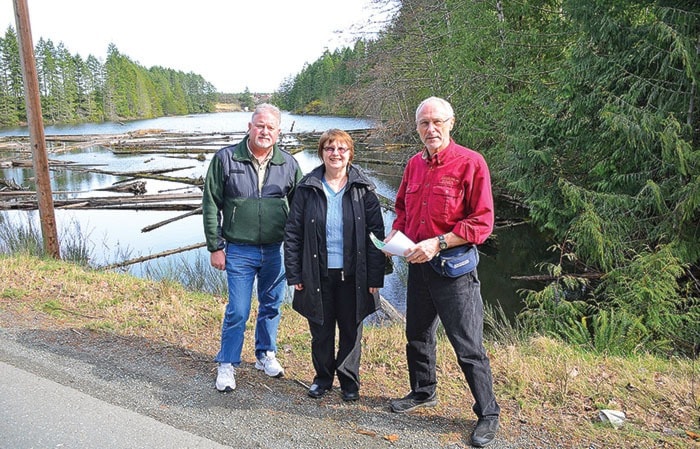Members of a local environmental group are raising the alarm with the city over a proposed soil remediation facility that they say threatens the city’s drinking water.
The committee’s concerns stem from an application from Upland Excavating to the province to expand its operations and accept non-hazardous contaminated soil at a landfill within the city’s watershed.
Upland has submitted a waste discharge application to the Ministry of Environment for an Operational Certificate to accommodate a landfill on Upland-owned lands at 7295 Gold River Highway that would treat and deposit up to 500,000 cubic metres of non-hazardous solid waste, such as construction, demolition and land-clearing materials, including asbestos.
At Monday’s council meeting, representatives from Upland presented their business case to city council and a packed public gallery.
Mark Stuart, son of Upland founder George Stuart, said the company is using the landfill as an opportunity to provide steady employment for more local people.
“The new venture would probably employ at least six people full-time and at times when various projects are going, 25 to 50 people part-time. We’re talking high-level, industrial income jobs,” Stuart said. “There’s an exodus of high-paying jobs in the Campbell River area right now and it’s a good opportunity to shore it up.”
But members of the Campbell River Environmental Committee (CREC) are concerned about the proposed landfill’s proximity to Rico Lake and McIvor Lake, which is connected to the city’s drinking water system.
Leona Adams, on behalf of the Environmental Committee, wrote a letter to council outlining the group’s concerns.
“The proposed waste landfill site straddles a large aquifer, which is hydraulically connected with Rico Lake and McIvor Lake,” Adams wrote. “There is a private drinking water well connected to the aquifer and therefore the proposal is in non-compliance with the BC Contaminated Sites Regulation TG6 for a landfill.”
Adams added that Rico Lake is only located 10 metres west of the proposed landfill site, which she said is substantially less than the 100- metre separation distance mandated by the 2015 Draft Landfill Criteria.
Adams said further that the committee is concerned about seepage from the proposed facility’s leachate and treatment system.
“Seepage will ultimately reach the vulnerable aquifer beneath Upland’s property,” Adams wrote. “This aquifer drains east into the Quinsam River Watershed, as well as to Cold Creek, which feeds the $100 million Quinsam River Hatchery, and to the Quinsam River. This will, over time, impact the pink salmon and steelhead Quinsam River fishery.”
Greg Ferraro, engineer for the project with GHD Consulting, said groundwater monitoring locations are located throughout the site and upgradient surface water quality will be monitored at both McIvor and Rico lakes. Ferraro added that water quality will meet the Ministry of Environment standards and will be monitored quarterly for verification.
He said the leachate treatment system, which involves an aeration pond and infiltration pond, would be located to the east of the landfill.
“Leachate from the base of the landfill will be collected and pumped into a treatment pond, called the aeration pond,” Ferraro said. “The key to this is it’s a batch treatment. The leachate will be treated to meet the standards as it is pumped to the infiltration pond and also be verified through a series of monitoring wells.”
Coun. Michele Babchuk said while she could understand the service Upland is trying to provide with the landfill, she was concerned that there is a risk that the tributaries surrounding the Quinsam Hatchery could end up receiving contaminated materials as a byproduct of the landfill.
Brian Fagan of Upland Excavating said the leachate will be treated in batches to ensure nothing gets by.
“Our forecast is for a seven-day (treatment schedule) and depending on what we see in the batch, it will require either more time or less time,” Fagan said. “Each batch will be treated and it will ensure that it doesn’t exceed the standards prior to discharge. The first level of treatment is the aeration which it does not get discharged to the next point in the system until such time that it has met the criteria. We’re not relying on downstream water, anything that we have, any attenuation at the discharge point will meet the requirements. You have to physically move a switch for it to flow from one pond to the next, so that would not happen if it didn’t meet the criteria. It is not discharged to the next point in the system before we ensure it meets the requirements.”
Still, Babchuk said she had some hesitation.
“I’m just a little bit concerned because I understand mitigating risk but I guess when it comes to our drinking water and fish at risk, I tend to lean towards not mitigation, but not having the risk there at all,” Babchuk said. “I do not have anything against the business plan; from my perspective it’s just in the wrong spot.”
Coun. Charlie Cornfield acknowledged that people’s concerns with the project are over the community’s drinking water and secondly, the hatchery.
“It’s up to us to make absolutely sure we’re mitigating that risk.”
Upland is currently in the community, local government and First Nations consultation phase.
The city will submit its comments on the project to Upland and the province and those comments will focus on ensuring potential impacts to the watershed, including those associated with drinking water and the environment, are addressed.
If the province does give its approval, before the project can go ahead, Upland will still need to acquire a watershed development permit from the city, which will trigger an environmental impact assessment, including a risk assessment.
Amber Zirnhelt, the city’s community planning and development services manager, said Upland may also need to apply for a rezoning permit in order to accommodate landfill uses on its property.
City staff’s comments on the project will go before council at its April 11 meeting.

Water is drawn from Rico Lake for industrial operations.
